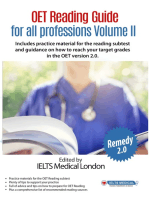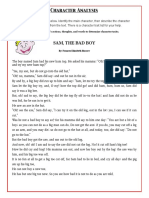Answering Application Questions
Uploaded by
Menon HariAnswering Application Questions
Uploaded by
Menon HariAnswering Application Questions (AQ)
Many General Paper (GP) students face difficulties when trying to answer the
Application Question (AQ) of the paper.
*****************************
Application Question or AQ is a long-answer question in the General Paper
comprehension paper that demands higher order thinking skills namely inferential
understanding, comparative analysis, critical evaluation and synthesis of information.
The examiners assess the AQ answer using 4 criteria: Requirements, Explanation,
Evaluation and Coherence.
A. Requirements
Band 1: Systematic reference to the requirements of the question with evidence of
balanced treatment.
1. Analyze the question
Always read the whole question carefully, every word, every phrase. Identify and
underline the question requirements.
Make sure you understand the central issues in the question, so that you can choose
arguments from the passage(s) and discuss them in light of the central issues
2. Identify and select the author's arguments
Having formed a good understanding of the question requirements and central
issues, identify the author’s arguments.
Select at least 3 of the author’s points you understand thoroughly.
Always keep the question in mind. Put it in front of you at all times while you select
arguments to check for relevance.
How to select the right arguments?
Locate the key arguments in the passage
Look for topic sentences in the passage
Look for controversial arguments
Passages are designed to invite evaluation. They are deliberately selected to include
controversial ideas and opinions within the arguments presented. One way will be
to select arguments that include absolute words or superlatives such as ONLY,
EVER, BEST etc.
From the summary: use points you understood earlier. Make sure you check the
summary question is similar to one of the central issues in the AQ.
Distinguish fact from opinion
3. Respond to the author's arguments
Brainstorm for your possible responses, and for relevant examples of your own.
Decide how much you want to agree / disagree with each argument from the author
If required, decide your overall stand towards the AQ. This must be based on
holistically, how much you agree / disagree with all the arguments from the
passages
Make references to your society / your generation/yourself or any other variations as
stated in the question.
B. Explanation
Band 1: Shows a good or very good understanding of terms and issues.
Explain the selected (author’s) argument in the context of the central issue of the
passage by paraphrasing the argument. You may quote the argument directly if it’s
self-explanatory.
Explain the situation in your society/generation etc. that supports your evaluation
Make sure arguments are not misinterpreted. If unsure of even just ONE
word/phrase, never choose it.
C. Evaluation
Band 1: Makes very convincing evaluation by making judgements and decisions and by
developing arguments to logical conclusions, and includes elaboration and support
through personal insight and apt illustration.
1. What do you need to do?
2. State your level of agreement on the identified argument
3. Evaluate the situation in your society / generation that supports your position,
through giving good reasons (Why do you agree / disagree?)
4. Provide good evidence to support your reasons
5. How do you evaluate?
6. Identify the claims and beliefs of the writer(s) about the issue.
7. Identify the reasons and evidence given in support of the claims.
8. How convincing are the claims/beliefs/reasons/ evidence? What do you think?
9. In comparing the arguments raised by both writers,
10. are there significant similarities and differences between the arguments?
11. is one more persuasive than the other? Why?
12. Assess the validity of arguments
13. Are the writers’ views one-sided / biased? Can you provide a fairer one?
14. Is the issue in the argument oversimplified? Are there other causes/reasons the
writer missed out (which are as, if not more, important)?
15. Is the evidence presented by the writer relevant and credible? Do you have more
evidence to substantiate or even to show otherwise?
D. Coherence
Band 1: Very clear shape and paragraph organization and cogent argument.
1. Coherence WITHIN a paragraph
Organization – points must flow logically in sequential order.
Linking words to glue the explanation and evaluation components together.
Use words in your response that resonate with the keywords given in the question.
2. Coherence ACROSS paragraphs
Use linking words to show balance
Ensure the overall stand is reflective of the sum of your evaluation of the writers’
arguments
You might also like
- Transactional Writing Prompts - Edexcel IGCSE100% (4)Transactional Writing Prompts - Edexcel IGCSE3 pages
- TOEFL Writing: Important Tips & High Scoring Sample Answers! (Written By A TOEFL Teacher)From EverandTOEFL Writing: Important Tips & High Scoring Sample Answers! (Written By A TOEFL Teacher)4.5/5 (6)
- Essays On The Topic of Sports and ExerciseNo ratings yetEssays On The Topic of Sports and Exercise13 pages
- California Treasures. Grade 3. Visual Vocabulary Resources100% (2)California Treasures. Grade 3. Visual Vocabulary Resources591 pages
- 50 Real Law School Personal Statements: And Everything You Need to Know to Write YoursFrom Everand50 Real Law School Personal Statements: And Everything You Need to Know to Write Yours5/5 (2)
- Understanding Essay Writing: A Guide To Writing Essays By Someone Who Grades ThemFrom EverandUnderstanding Essay Writing: A Guide To Writing Essays By Someone Who Grades Them4/5 (4)
- Teaching Business Writing: A Good Refresher and Quick ReferenceFrom EverandTeaching Business Writing: A Good Refresher and Quick ReferenceNo ratings yet
- How to Write a Dissertation: An Instructional Manual for Dissertation Writers.From EverandHow to Write a Dissertation: An Instructional Manual for Dissertation Writers.No ratings yet
- Conquer the New SAT Essay: A Skilled Professor Teaches the 2016 SAT Essay SectionFrom EverandConquer the New SAT Essay: A Skilled Professor Teaches the 2016 SAT Essay Section2.5/5 (3)
- IELTS Writing Task 2: a Step-by-Step Guide: Everything You Need to Know: Strategies, Tips and Traps, Ideas and VocabularyFrom EverandIELTS Writing Task 2: a Step-by-Step Guide: Everything You Need to Know: Strategies, Tips and Traps, Ideas and VocabularyNo ratings yet
- Muse The World: How To Write An Evaluation in AQ? (Updated 26/5/09)No ratings yetMuse The World: How To Write An Evaluation in AQ? (Updated 26/5/09)9 pages
- Lecture 1-P1 Skills-Question Interpretation - QA - BrainstormingNo ratings yetLecture 1-P1 Skills-Question Interpretation - QA - Brainstorming25 pages
- The Student’s Guide to Writing: Essential Outlines and StrategiesFrom EverandThe Student’s Guide to Writing: Essential Outlines and StrategiesNo ratings yet
- IELTS High Score Guide (Academic) - 50 Important Rules You Must Know To Achieve A High Score!From EverandIELTS High Score Guide (Academic) - 50 Important Rules You Must Know To Achieve A High Score!1/5 (1)
- Princeton Review AP Computer Science A Prep, 8th Edition: 5 Practice Tests + Complete Content Review + Strategies & TechniquesFrom EverandPrinceton Review AP Computer Science A Prep, 8th Edition: 5 Practice Tests + Complete Content Review + Strategies & Techniques5/5 (1)
- Advanced Academic English: A handbook for university writing with glossaryFrom EverandAdvanced Academic English: A handbook for university writing with glossaryNo ratings yet
- IELTS High Score Guide (General Training) - 50 Important Rules You Must Know To Achieve A High Score!From EverandIELTS High Score Guide (General Training) - 50 Important Rules You Must Know To Achieve A High Score!3/5 (7)
- IELTS High Score System: Learn How To Identify & Answer Every Question With A High Score!From EverandIELTS High Score System: Learn How To Identify & Answer Every Question With A High Score!3/5 (2)
- Korean Conversations and Debating: A Language Guide for Self-Study or Classroom Use--Learn to Talk About Current Topics in Korean (With Companion Online Audio)From EverandKorean Conversations and Debating: A Language Guide for Self-Study or Classroom Use--Learn to Talk About Current Topics in Korean (With Companion Online Audio)No ratings yet
- How to Successfully Deal with Your Dissertation DataFrom EverandHow to Successfully Deal with Your Dissertation DataNo ratings yet
- Emarking Notes on English HSSC-I May Exam 2012No ratings yetEmarking Notes on English HSSC-I May Exam 20127 pages
- Agree or Disagree: 52 Writing Prompts for Opinion Essays: English Prompts, #2From EverandAgree or Disagree: 52 Writing Prompts for Opinion Essays: English Prompts, #2No ratings yet
- AFOQT Exam Study Guide Complete Review for the Air Force Officer Qualifying TestFrom EverandAFOQT Exam Study Guide Complete Review for the Air Force Officer Qualifying TestNo ratings yet
- AQA Psychology BRILLIANT MODEL ANSWERS: Attachments: AS and A-levelFrom EverandAQA Psychology BRILLIANT MODEL ANSWERS: Attachments: AS and A-levelNo ratings yet
- The Official ACT Prep Guide, 2018-19 Edition (Book + Bonus Online Content)From EverandThe Official ACT Prep Guide, 2018-19 Edition (Book + Bonus Online Content)No ratings yet
- Common Core Snapshot: Administrator's Guide to the Common CoreFrom EverandCommon Core Snapshot: Administrator's Guide to the Common CoreNo ratings yet
- The Scholarship and College Essay Planning Kit: A Guide for Uneasy Student WritersFrom EverandThe Scholarship and College Essay Planning Kit: A Guide for Uneasy Student Writers5/5 (1)
- A Non-Freaked Out Guide to Teaching the Common Core: Using the 32 Literacy Anchor Standards to Develop College- and Career-Ready StudentsFrom EverandA Non-Freaked Out Guide to Teaching the Common Core: Using the 32 Literacy Anchor Standards to Develop College- and Career-Ready StudentsNo ratings yet
- Global Issues (Fields of Inquiry) & Areas of ExplorationNo ratings yetGlobal Issues (Fields of Inquiry) & Areas of Exploration2 pages
- NY The Weekend Essay The Case Against Travel June 2023No ratings yetNY The Weekend Essay The Case Against Travel June 20238 pages
- Characteristics of An Effective ParagraphNo ratings yetCharacteristics of An Effective Paragraph12 pages
- Get Military Virtues 1 Issues in Military Ethics Michael Skerker (Editor) free all chapters100% (6)Get Military Virtues 1 Issues in Military Ethics Michael Skerker (Editor) free all chapters50 pages
- A Theory of The Musical Genre: The Three-Phase Cycle: Ii. Cognitive Category, Taxonomic Class, or Cultual Unit?100% (1)A Theory of The Musical Genre: The Three-Phase Cycle: Ii. Cognitive Category, Taxonomic Class, or Cultual Unit?3 pages
- W - Determine The Speed of Block A After It Moves: Problem 14-65No ratings yetW - Determine The Speed of Block A After It Moves: Problem 14-6532 pages
- Key Concepts and Ideas of Filipino Thinkers inNo ratings yetKey Concepts and Ideas of Filipino Thinkers in45 pages
- Edmund Price - The Science of Self DefenceNo ratings yetEdmund Price - The Science of Self Defence52 pages
















































































































